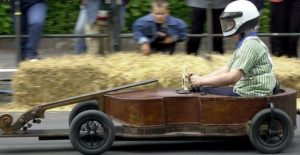Kay and Volkswagen: Products for the People
I’m an old-car guy and have kept and worked on various Volkswagen products over the years. Something occurred to me one day that I think could be illuminating in looking at these instruments. In terms of their customer targets and approach to serving them, Kay was a lot like Volkswagen in its air-cooled days.
It turns out I’m not the first to see with this analogy, but I hope you’ll indulge me for a minute
In the economically bleak days of Europe after the war, few could afford food, let alone a car, and the auto industry had to find a way to rebuild from the rubble up. The answer was American-style mass-production technology and the small, cheap, underpowered cars of the late ’40s and ’50s, VW a leader among them. When the Beetle began to appear on US streets in the late ’50s, many made a joke of them. But for certain up-and-coming populations, including younger urbanites who didn’t need to do much driving and suburban families newly needing a second car for daily errands, it was affordable, cute, easy to park and, well, enough.
Kay’s business began with parlor guitars and such as radio was catching on, disposable incomes were rising across the board, and playing popular music at home expanded into less affluent homes. The urge to play continued as the Depression eliminated that ready cash, but few could afford a handmade bass or cello for Junior to learn on. Furniture makers were making strides with plywood and, along with several others, Henry Kuhrmeyer’s company saw the opportunity to offer cheap, durable instruments for students. Bass and cello production began in 1937, just as the first what would become the Beetle was shaping up in the Porsche factory.
After the war, school music programs swelled with Boomer kids from a vastly expanding middle class, and Kay production took off. Like the Beetle, a Kay bass or cello was enough to get a good start on, and it served well for devotees of popular music. You could strap a Kay bass on top of the car, drive 200 miles and count on playing the show with it, no problem, squashed bugs and all. The little country church could afford it for revivals, and it didn’t mind mountain weather or harsh treatment. Like the People’s Car, Kay became the People’s Bass.
When production of the air-cooled Beetle ended in 2003, VW worldwide had produced over 21.5 million of them, the largest number of cars built on the same platform ever before and likely ever, period.
Between 1937 and ’69 we think Kay made up to around 60,000 basses and cellos. Stacked against the production of other luthieries, that’s an impressive number, far more than any contemporary company worldwide. Englehardt-Link picked up the torch and continued building for another 50 years, serving the same kinds of customers.
Like the VW, you can soup up a Kay bass and get more out of it, but no one will seriously call it a high-performance product. It wasn’t meant to be, and shouldn’t be judged on those terms. But in terms of sales, longevity and customer loyalty, it is clearly at least among the most successful designs ever. That’s something to applaud, I think.
